Analysis of Finance Options for Zylla Ltd's New Ferry Purchase - FY005
VerifiedAdded on 2023/03/20
|5
|1323
|20
Report
AI Summary
This report, prepared for Zylla Limited, a ferry operator, assesses the financial viability of purchasing a new ferry to meet increased demand. It explores both short-term and long-term sources of finance, including trade credit, bank credit (overdrafts and loans), equity, retained earnings, debentures, and debt. The report then evaluates the project's feasibility using discounted cash flow methods, specifically Net Present Value (NPV), Internal Rate of Return (IRR), and Payback Period. The NPV calculation, using a 3% discount rate, yields £209,973. The payback period is determined to be 2.28 years, and the IRR is calculated to be 39.02%. Based on these results, the report concludes that the ferry purchase is a worthwhile investment, recommending that Zylla Limited proceed with the acquisition.
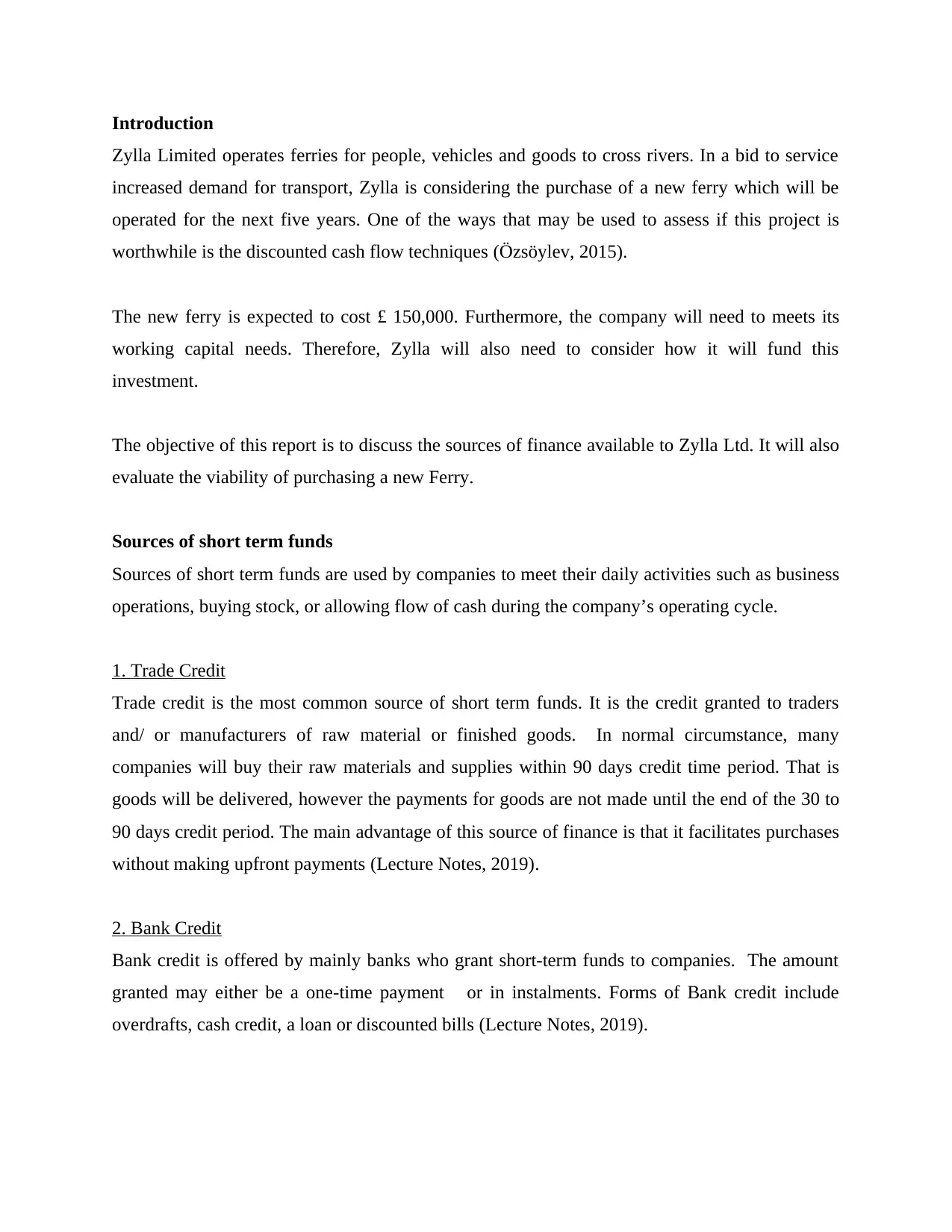
Introduction
Zylla Limited operates ferries for people, vehicles and goods to cross rivers. In a bid to service
increased demand for transport, Zylla is considering the purchase of a new ferry which will be
operated for the next five years. One of the ways that may be used to assess if this project is
worthwhile is the discounted cash flow techniques (Özsöylev, 2015).
The new ferry is expected to cost £ 150,000. Furthermore, the company will need to meets its
working capital needs. Therefore, Zylla will also need to consider how it will fund this
investment.
The objective of this report is to discuss the sources of finance available to Zylla Ltd. It will also
evaluate the viability of purchasing a new Ferry.
Sources of short term funds
Sources of short term funds are used by companies to meet their daily activities such as business
operations, buying stock, or allowing flow of cash during the company’s operating cycle.
1. Trade Credit
Trade credit is the most common source of short term funds. It is the credit granted to traders
and/ or manufacturers of raw material or finished goods. In normal circumstance, many
companies will buy their raw materials and supplies within 90 days credit time period. That is
goods will be delivered, however the payments for goods are not made until the end of the 30 to
90 days credit period. The main advantage of this source of finance is that it facilitates purchases
without making upfront payments (Lecture Notes, 2019).
2. Bank Credit
Bank credit is offered by mainly banks who grant short-term funds to companies. The amount
granted may either be a one-time payment or in instalments. Forms of Bank credit include
overdrafts, cash credit, a loan or discounted bills (Lecture Notes, 2019).
Zylla Limited operates ferries for people, vehicles and goods to cross rivers. In a bid to service
increased demand for transport, Zylla is considering the purchase of a new ferry which will be
operated for the next five years. One of the ways that may be used to assess if this project is
worthwhile is the discounted cash flow techniques (Özsöylev, 2015).
The new ferry is expected to cost £ 150,000. Furthermore, the company will need to meets its
working capital needs. Therefore, Zylla will also need to consider how it will fund this
investment.
The objective of this report is to discuss the sources of finance available to Zylla Ltd. It will also
evaluate the viability of purchasing a new Ferry.
Sources of short term funds
Sources of short term funds are used by companies to meet their daily activities such as business
operations, buying stock, or allowing flow of cash during the company’s operating cycle.
1. Trade Credit
Trade credit is the most common source of short term funds. It is the credit granted to traders
and/ or manufacturers of raw material or finished goods. In normal circumstance, many
companies will buy their raw materials and supplies within 90 days credit time period. That is
goods will be delivered, however the payments for goods are not made until the end of the 30 to
90 days credit period. The main advantage of this source of finance is that it facilitates purchases
without making upfront payments (Lecture Notes, 2019).
2. Bank Credit
Bank credit is offered by mainly banks who grant short-term funds to companies. The amount
granted may either be a one-time payment or in instalments. Forms of Bank credit include
overdrafts, cash credit, a loan or discounted bills (Lecture Notes, 2019).
Paraphrase This Document
Need a fresh take? Get an instant paraphrase of this document with our AI Paraphraser
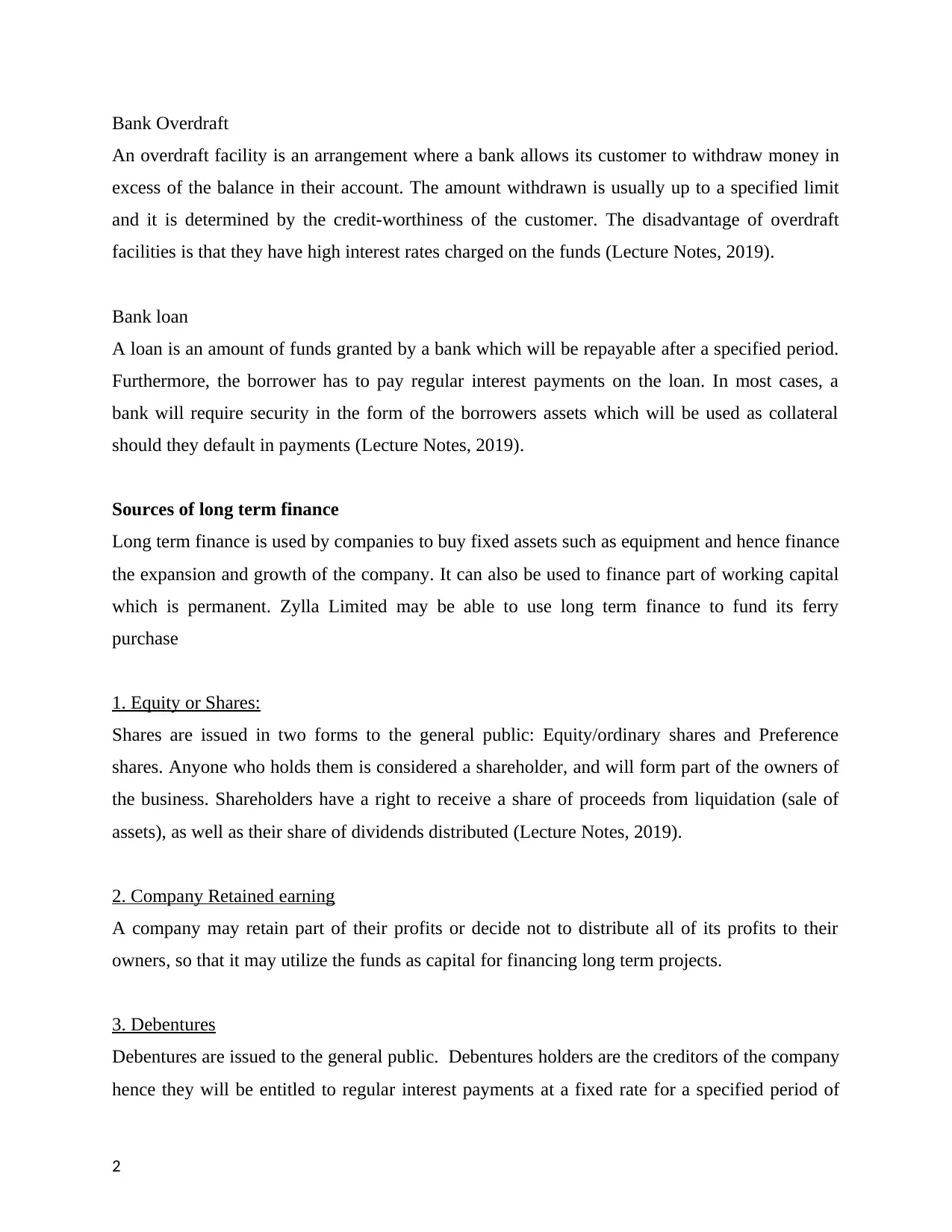
Bank Overdraft
An overdraft facility is an arrangement where a bank allows its customer to withdraw money in
excess of the balance in their account. The amount withdrawn is usually up to a specified limit
and it is determined by the credit-worthiness of the customer. The disadvantage of overdraft
facilities is that they have high interest rates charged on the funds (Lecture Notes, 2019).
Bank loan
A loan is an amount of funds granted by a bank which will be repayable after a specified period.
Furthermore, the borrower has to pay regular interest payments on the loan. In most cases, a
bank will require security in the form of the borrowers assets which will be used as collateral
should they default in payments (Lecture Notes, 2019).
Sources of long term finance
Long term finance is used by companies to buy fixed assets such as equipment and hence finance
the expansion and growth of the company. It can also be used to finance part of working capital
which is permanent. Zylla Limited may be able to use long term finance to fund its ferry
purchase
1. Equity or Shares:
Shares are issued in two forms to the general public: Equity/ordinary shares and Preference
shares. Anyone who holds them is considered a shareholder, and will form part of the owners of
the business. Shareholders have a right to receive a share of proceeds from liquidation (sale of
assets), as well as their share of dividends distributed (Lecture Notes, 2019).
2. Company Retained earning
A company may retain part of their profits or decide not to distribute all of its profits to their
owners, so that it may utilize the funds as capital for financing long term projects.
3. Debentures
Debentures are issued to the general public. Debentures holders are the creditors of the company
hence they will be entitled to regular interest payments at a fixed rate for a specified period of
2
An overdraft facility is an arrangement where a bank allows its customer to withdraw money in
excess of the balance in their account. The amount withdrawn is usually up to a specified limit
and it is determined by the credit-worthiness of the customer. The disadvantage of overdraft
facilities is that they have high interest rates charged on the funds (Lecture Notes, 2019).
Bank loan
A loan is an amount of funds granted by a bank which will be repayable after a specified period.
Furthermore, the borrower has to pay regular interest payments on the loan. In most cases, a
bank will require security in the form of the borrowers assets which will be used as collateral
should they default in payments (Lecture Notes, 2019).
Sources of long term finance
Long term finance is used by companies to buy fixed assets such as equipment and hence finance
the expansion and growth of the company. It can also be used to finance part of working capital
which is permanent. Zylla Limited may be able to use long term finance to fund its ferry
purchase
1. Equity or Shares:
Shares are issued in two forms to the general public: Equity/ordinary shares and Preference
shares. Anyone who holds them is considered a shareholder, and will form part of the owners of
the business. Shareholders have a right to receive a share of proceeds from liquidation (sale of
assets), as well as their share of dividends distributed (Lecture Notes, 2019).
2. Company Retained earning
A company may retain part of their profits or decide not to distribute all of its profits to their
owners, so that it may utilize the funds as capital for financing long term projects.
3. Debentures
Debentures are issued to the general public. Debentures holders are the creditors of the company
hence they will be entitled to regular interest payments at a fixed rate for a specified period of
2
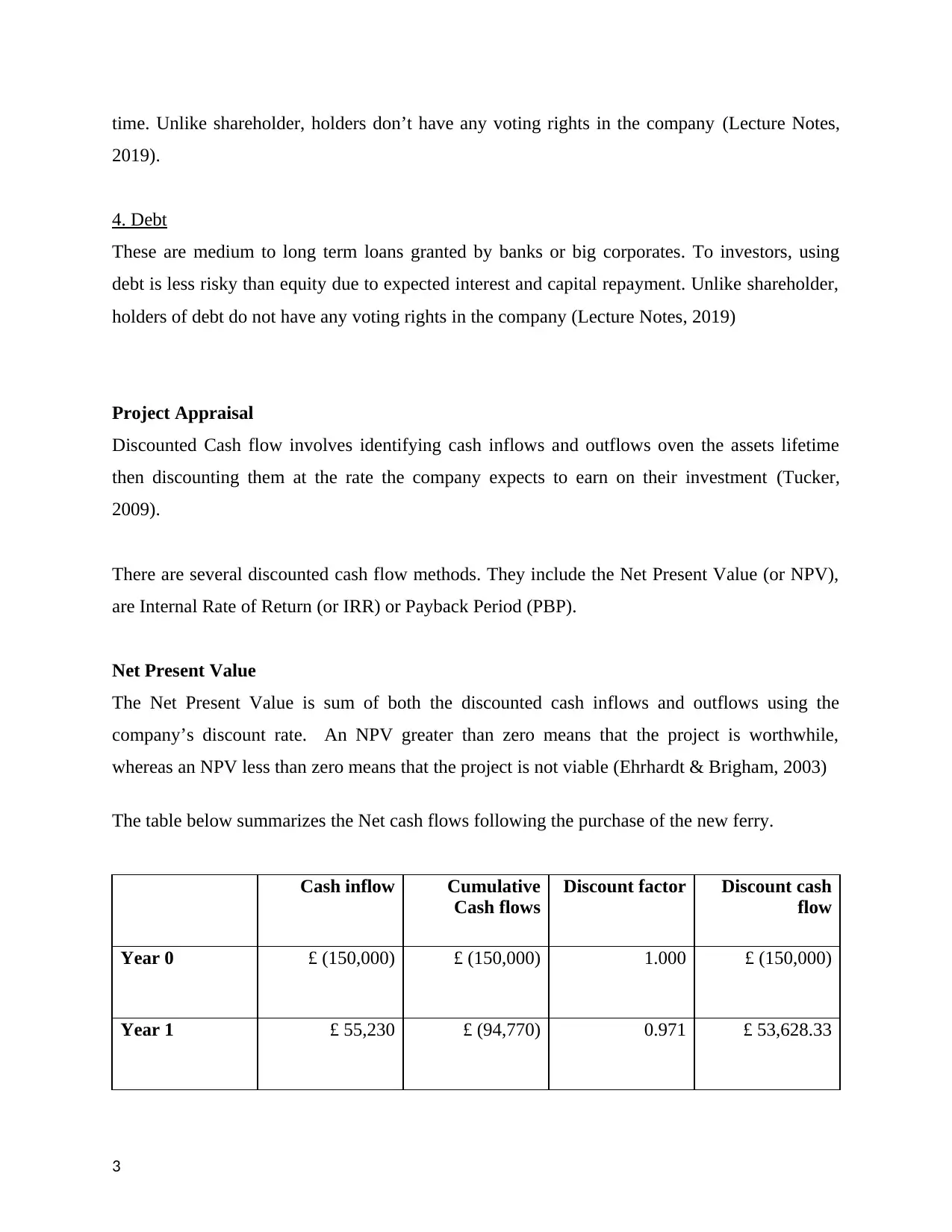
time. Unlike shareholder, holders don’t have any voting rights in the company (Lecture Notes,
2019).
4. Debt
These are medium to long term loans granted by banks or big corporates. To investors, using
debt is less risky than equity due to expected interest and capital repayment. Unlike shareholder,
holders of debt do not have any voting rights in the company (Lecture Notes, 2019)
Project Appraisal
Discounted Cash flow involves identifying cash inflows and outflows oven the assets lifetime
then discounting them at the rate the company expects to earn on their investment (Tucker,
2009).
There are several discounted cash flow methods. They include the Net Present Value (or NPV),
are Internal Rate of Return (or IRR) or Payback Period (PBP).
Net Present Value
The Net Present Value is sum of both the discounted cash inflows and outflows using the
company’s discount rate. An NPV greater than zero means that the project is worthwhile,
whereas an NPV less than zero means that the project is not viable (Ehrhardt & Brigham, 2003)
The table below summarizes the Net cash flows following the purchase of the new ferry.
Cash inflow Cumulative
Cash flows
Discount factor Discount cash
flow
Year 0 £ (150,000) £ (150,000) 1.000 £ (150,000)
Year 1 £ 55,230 £ (94,770) 0.971 £ 53,628.33
3
2019).
4. Debt
These are medium to long term loans granted by banks or big corporates. To investors, using
debt is less risky than equity due to expected interest and capital repayment. Unlike shareholder,
holders of debt do not have any voting rights in the company (Lecture Notes, 2019)
Project Appraisal
Discounted Cash flow involves identifying cash inflows and outflows oven the assets lifetime
then discounting them at the rate the company expects to earn on their investment (Tucker,
2009).
There are several discounted cash flow methods. They include the Net Present Value (or NPV),
are Internal Rate of Return (or IRR) or Payback Period (PBP).
Net Present Value
The Net Present Value is sum of both the discounted cash inflows and outflows using the
company’s discount rate. An NPV greater than zero means that the project is worthwhile,
whereas an NPV less than zero means that the project is not viable (Ehrhardt & Brigham, 2003)
The table below summarizes the Net cash flows following the purchase of the new ferry.
Cash inflow Cumulative
Cash flows
Discount factor Discount cash
flow
Year 0 £ (150,000) £ (150,000) 1.000 £ (150,000)
Year 1 £ 55,230 £ (94,770) 0.971 £ 53,628.33
3
⊘ This is a preview!⊘
Do you want full access?
Subscribe today to unlock all pages.

Trusted by 1+ million students worldwide
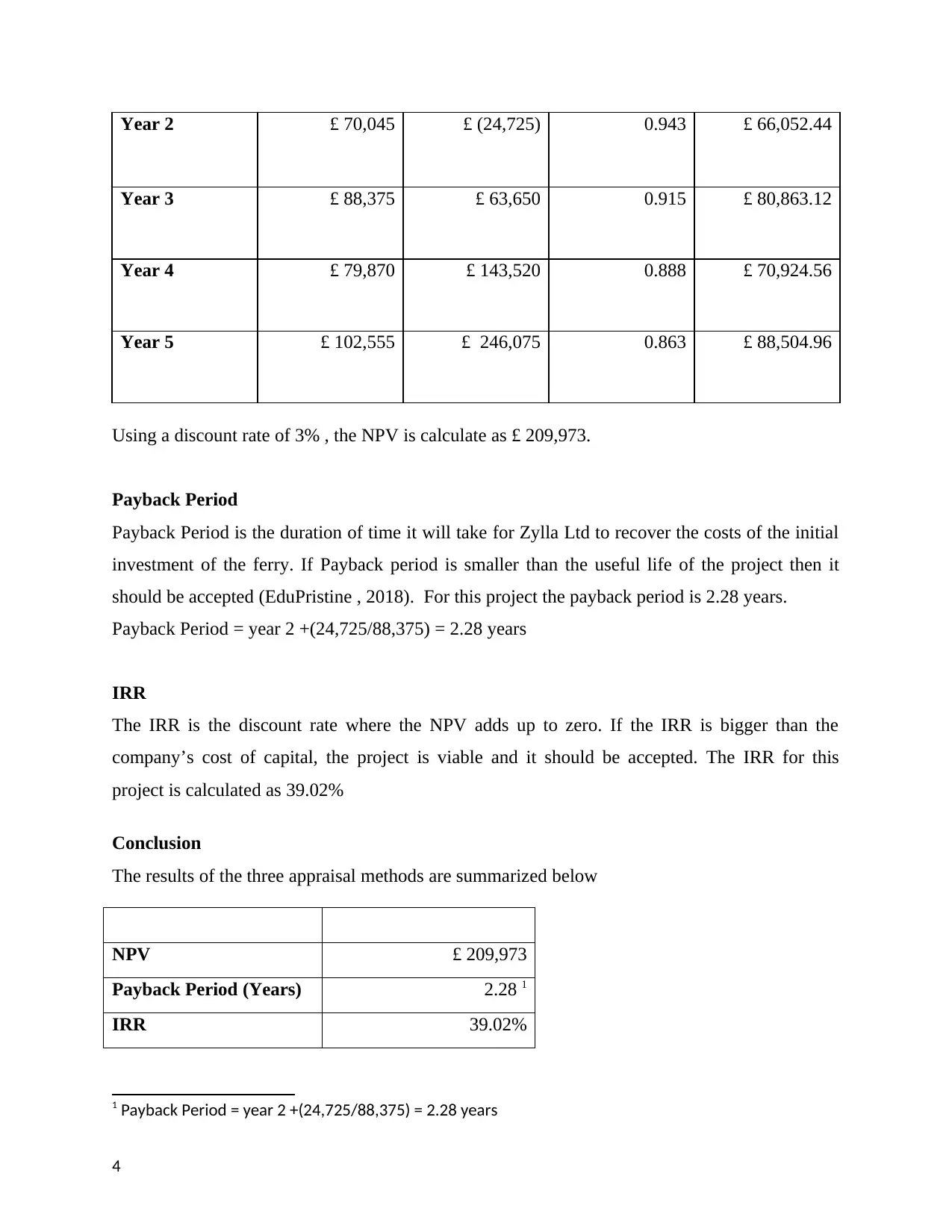
Year 2 £ 70,045 £ (24,725) 0.943 £ 66,052.44
Year 3 £ 88,375 £ 63,650 0.915 £ 80,863.12
Year 4 £ 79,870 £ 143,520 0.888 £ 70,924.56
Year 5 £ 102,555 £ 246,075 0.863 £ 88,504.96
Using a discount rate of 3% , the NPV is calculate as £ 209,973.
Payback Period
Payback Period is the duration of time it will take for Zylla Ltd to recover the costs of the initial
investment of the ferry. If Payback period is smaller than the useful life of the project then it
should be accepted (EduPristine , 2018). For this project the payback period is 2.28 years.
Payback Period = year 2 +(24,725/88,375) = 2.28 years
IRR
The IRR is the discount rate where the NPV adds up to zero. If the IRR is bigger than the
company’s cost of capital, the project is viable and it should be accepted. The IRR for this
project is calculated as 39.02%
Conclusion
The results of the three appraisal methods are summarized below
NPV £ 209,973
Payback Period (Years) 2.28 1
IRR 39.02%
1 Payback Period = year 2 +(24,725/88,375) = 2.28 years
4
Year 3 £ 88,375 £ 63,650 0.915 £ 80,863.12
Year 4 £ 79,870 £ 143,520 0.888 £ 70,924.56
Year 5 £ 102,555 £ 246,075 0.863 £ 88,504.96
Using a discount rate of 3% , the NPV is calculate as £ 209,973.
Payback Period
Payback Period is the duration of time it will take for Zylla Ltd to recover the costs of the initial
investment of the ferry. If Payback period is smaller than the useful life of the project then it
should be accepted (EduPristine , 2018). For this project the payback period is 2.28 years.
Payback Period = year 2 +(24,725/88,375) = 2.28 years
IRR
The IRR is the discount rate where the NPV adds up to zero. If the IRR is bigger than the
company’s cost of capital, the project is viable and it should be accepted. The IRR for this
project is calculated as 39.02%
Conclusion
The results of the three appraisal methods are summarized below
NPV £ 209,973
Payback Period (Years) 2.28 1
IRR 39.02%
1 Payback Period = year 2 +(24,725/88,375) = 2.28 years
4
Paraphrase This Document
Need a fresh take? Get an instant paraphrase of this document with our AI Paraphraser
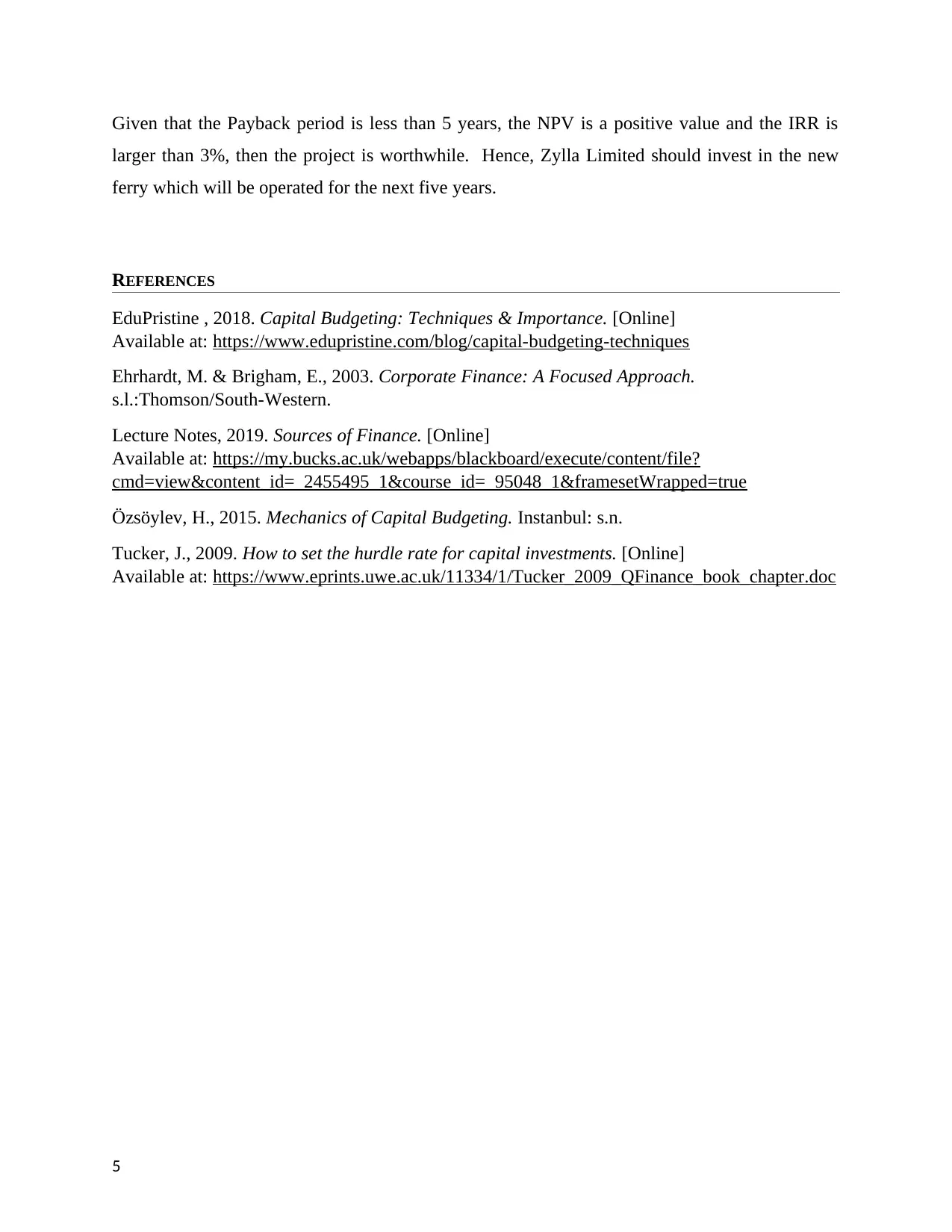
Given that the Payback period is less than 5 years, the NPV is a positive value and the IRR is
larger than 3%, then the project is worthwhile. Hence, Zylla Limited should invest in the new
ferry which will be operated for the next five years.
REFERENCES
EduPristine , 2018. Capital Budgeting: Techniques & Importance. [Online]
Available at: https://www.edupristine.com/blog/capital-budgeting-techniques
Ehrhardt, M. & Brigham, E., 2003. Corporate Finance: A Focused Approach.
s.l.:Thomson/South-Western.
Lecture Notes, 2019. Sources of Finance. [Online]
Available at: https://my.bucks.ac.uk/webapps/blackboard/execute/content/file?
cmd=view&content_id=_2455495_1&course_id=_95048_1&framesetWrapped=true
Özsöylev, H., 2015. Mechanics of Capital Budgeting. Instanbul: s.n.
Tucker, J., 2009. How to set the hurdle rate for capital investments. [Online]
Available at: https://www.eprints.uwe.ac.uk/11334/1/Tucker_2009_QFinance_book_chapter.doc
5
larger than 3%, then the project is worthwhile. Hence, Zylla Limited should invest in the new
ferry which will be operated for the next five years.
REFERENCES
EduPristine , 2018. Capital Budgeting: Techniques & Importance. [Online]
Available at: https://www.edupristine.com/blog/capital-budgeting-techniques
Ehrhardt, M. & Brigham, E., 2003. Corporate Finance: A Focused Approach.
s.l.:Thomson/South-Western.
Lecture Notes, 2019. Sources of Finance. [Online]
Available at: https://my.bucks.ac.uk/webapps/blackboard/execute/content/file?
cmd=view&content_id=_2455495_1&course_id=_95048_1&framesetWrapped=true
Özsöylev, H., 2015. Mechanics of Capital Budgeting. Instanbul: s.n.
Tucker, J., 2009. How to set the hurdle rate for capital investments. [Online]
Available at: https://www.eprints.uwe.ac.uk/11334/1/Tucker_2009_QFinance_book_chapter.doc
5
1 out of 5
Related Documents
Your All-in-One AI-Powered Toolkit for Academic Success.
+13062052269
info@desklib.com
Available 24*7 on WhatsApp / Email
![[object Object]](/_next/static/media/star-bottom.7253800d.svg)
Unlock your academic potential
Copyright © 2020–2025 A2Z Services. All Rights Reserved. Developed and managed by ZUCOL.




